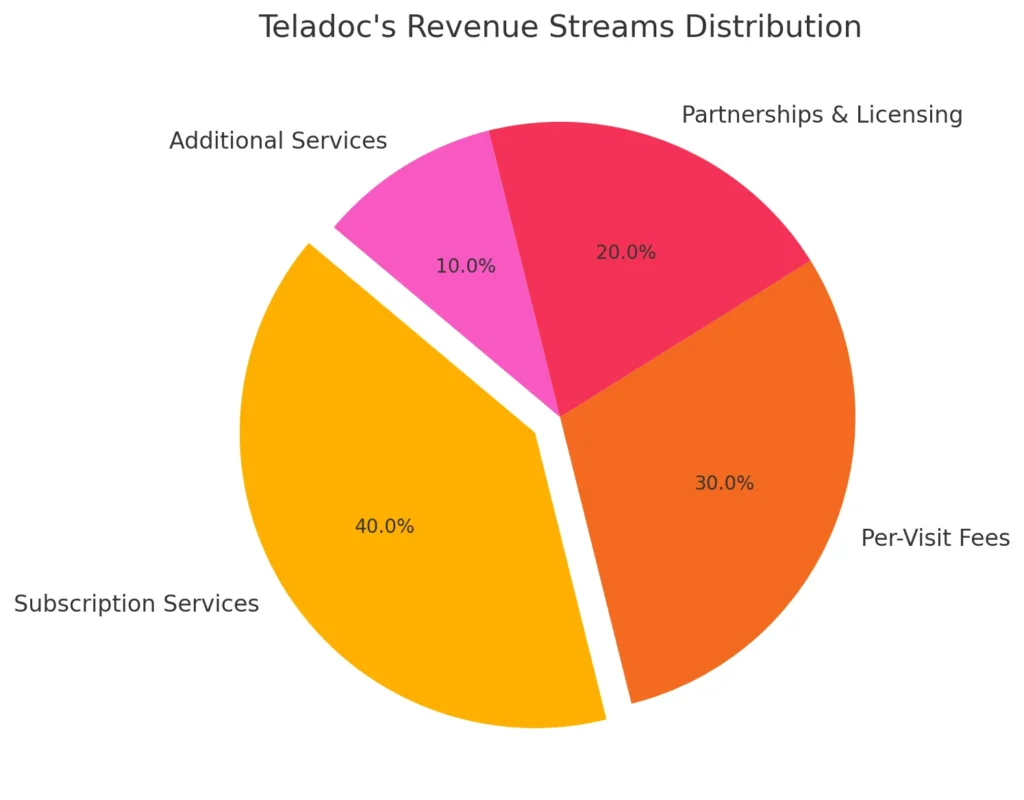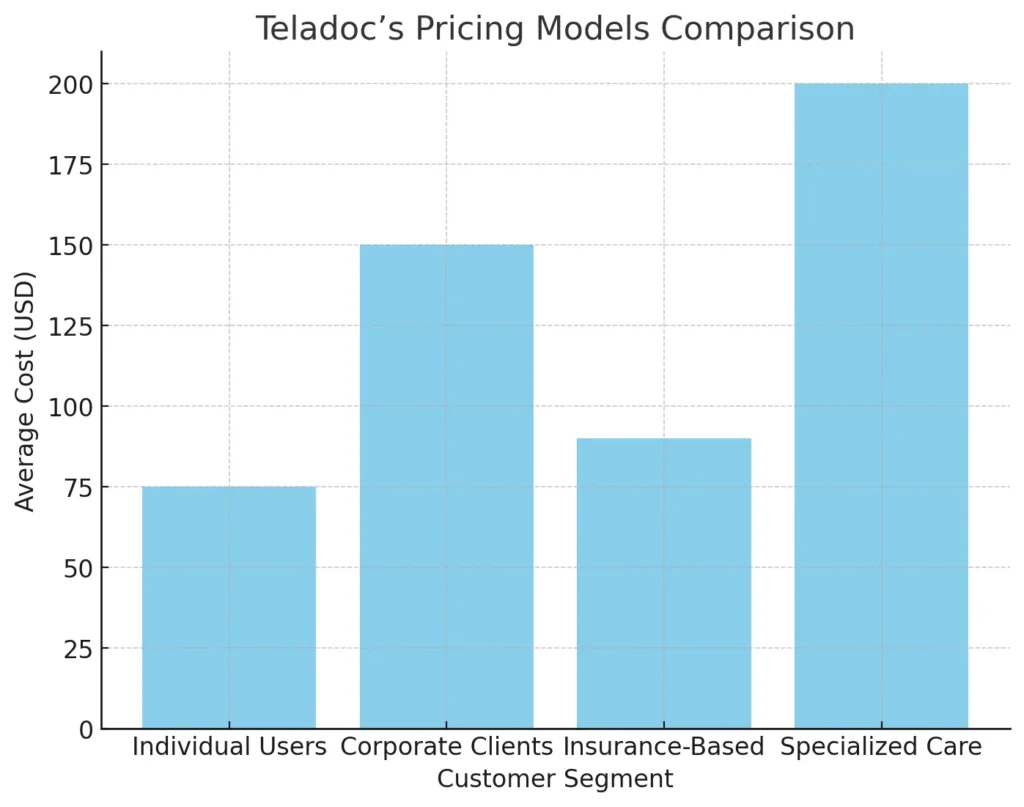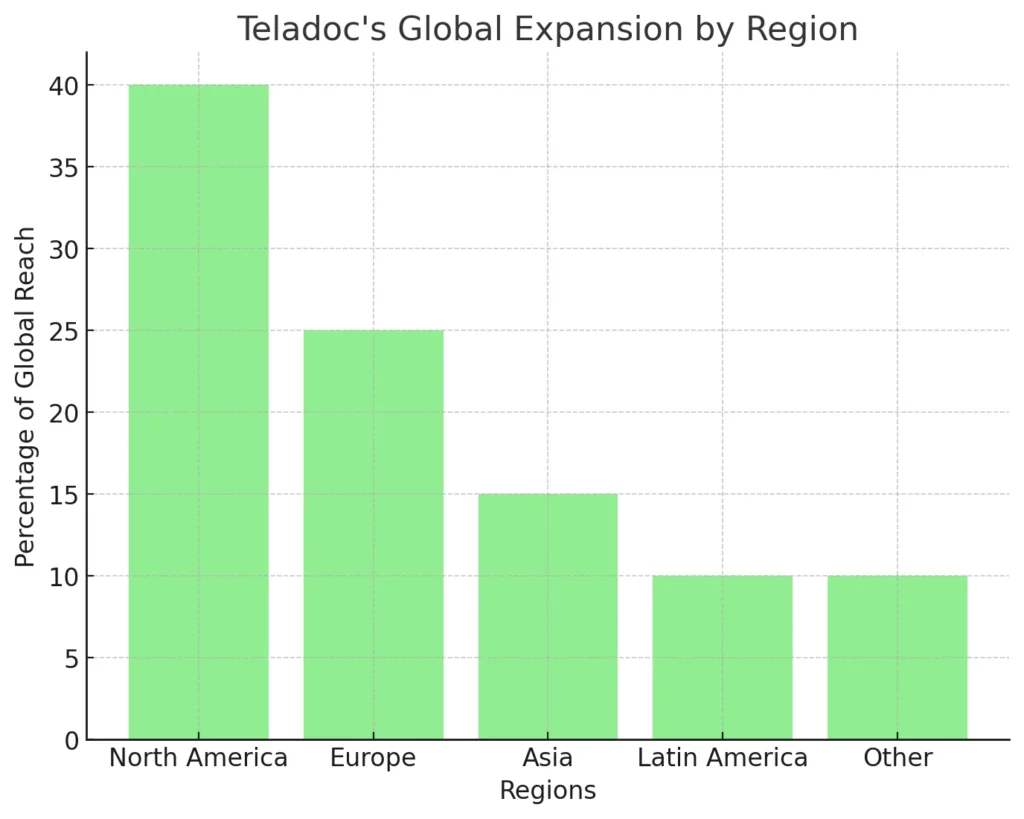Teladoc Health is a trailblazer in the telemedicine industry, offering On-Demand Healthcare Services Development to millions of users globally. As the demand for online healthcare surges, understanding Teladoc’s monetization model is crucial for businesses looking to enter or scale within the telemedicine space. Teladoc has built a comprehensive ecosystem that leverages its vast network of healthcare providers, partnerships, and cutting-edge technology to generate revenue efficiently.
This blog delves into the intricate workings of Teladoc’s business and monetization model, highlighting how it dominates the telemedicine market by offering a combination of subscription-based services, per-visit fees, and digital healthcare solutions. Whether you’re an entrepreneur looking to build a telemedicine platform or a healthcare professional curious about monetizing online healthcare, this guide will offer valuable insights into how Teladoc generates revenue while maintaining its competitive edge.
Teladoc’s ability to monetize virtual healthcare while ensuring scalability, user satisfaction, and global expansion is what sets it apart from competitors. Let’s explore how Teladoc’s model works and why it is so successful in the rapidly growing digital healthcare sector.
Also Read :- Top 10 Ideas for Healthcare and Telemedicine Business Startups
Teladoc’s Business Model Overview
Teladoc’s business model is built around providing accessible, on-demand healthcare services via virtual platforms, offering patients 24/7 access to medical professionals without the need for in-person visits. At the core of its model is the ability to streamline healthcare delivery while maintaining high levels of convenience and efficiency for both patients and providers.
Teladoc’s model operates primarily through digital channels, including telehealth consultations, mental health services, chronic care management, and second medical opinions. This ecosystem allows it to meet the growing demand for healthcare that can be accessed from anywhere at any time, catering to a wide range of needs—from routine check-ups to specialist consultations.
A major aspect of Teladoc’s business model is its focus on scalability. Teladoc partners with individual healthcare professionals, large healthcare systems, employers, and insurers, providing them with flexible solutions to meet their specific needs. By integrating with various healthcare systems and insurance networks, Teladoc ensures that its platform is widely accessible, reaching a vast number of users globally.
Through its strategic partnerships and innovative platform design, Teladoc has positioned itself as a leader in the telemedicine space, effectively creating a sustainable and scalable business model that meets the demands of modern healthcare consumers.
Also Read :- How to Build a Medical App Like MyChart
Market Analysis & Industry Trends
The telemedicine market has witnessed exponential growth in recent years, driven by advancements in technology, evolving consumer preferences, and the global push for more accessible healthcare solutions. The COVID-19 pandemic further accelerated the adoption of virtual healthcare, making telemedicine a mainstream option. By 2023, the global telemedicine market was valued at over $60 billion and is expected to grow at a double-digit rate over the next few years.
Teladoc, as a pioneer in this space, has capitalized on these trends, positioning itself as a dominant force. Its ability to offer comprehensive, scalable services has been key to gaining market share. Telemedicine is no longer just a convenient option; it has become essential, and Teladoc has strategically aligned itself with these industry shifts by expanding its offerings, investing in technology, and establishing key partnerships with insurers and healthcare providers.
As competition intensifies, Teladoc’s future growth lies in its ability to innovate and adapt to changing market dynamics. The increasing demand for personalized healthcare solutions, such as chronic care management and mental health services, also provides ample growth opportunities for the company.
The global telemedicine market has experienced significant growth, with the industry projected to expand even further in the coming years. For detailed insights and growth forecasts, check out this report on the telemedicine industry.
Key Revenue Streams in Teladoc’s Monetization Model
| Revenue Stream | Description | Example |
|---|---|---|
| Subscription-Based | Recurring payments from employers or insurers | Corporate healthcare plans |
| Per-Visit Fees | Fees charged for individual consultations | General consultation or mental health |
| Partnerships & Licensing | Revenue from hospitals or insurers licensing Teladoc’s platform | Licensing services to local providers |
| Additional Services | Revenue from specialized healthcare services | Chronic care management or dermatology |
Teladoc has established multiple revenue streams, each contributing to its robust monetization model. Here’s a breakdown of its primary sources of income:
- Subscription-Based Services: Teladoc offers subscription plans to organizations, insurers, and employers. These companies pay Teladoc a fixed fee to provide their employees or customers with access to virtual healthcare services. This recurring revenue model ensures steady income.
- Per-Visit Fees: For patients who do not fall under a subscription plan, Teladoc charges a fee for each telemedicine consultation. This fee varies depending on the type of consultation (e.g., general practitioner, specialist, or mental health).
- Partnerships & Licensing: Teladoc partners with hospitals, health systems, and insurers, licensing its technology and infrastructure to enable these organizations to offer telemedicine services under their own branding. This generates additional revenue while allowing Teladoc to expand its reach without directly managing all consultations.
- Additional Services: Teladoc generates income from offering specialized services such as mental health, dermatology, and chronic disease management programs, broadening its appeal and tapping into higher-margin areas of healthcare.

This diversified revenue model has made Teladoc resilient in an increasingly competitive telemedicine market, allowing it to adapt and grow its business despite changes in healthcare regulations and market demand.
To get a deeper understanding of Teladoc’s financial performance and revenue streams, you can explore their official investor relations page.
Cost and Pricing Models for Consumers
| Customer Segment | Pricing Model | Example Pricing (Approx.) |
|---|---|---|
| Individual Users | Per-visit fees for each consultation | $75-$299 per visit (service-dependent) |
| Corporate Clients | Subscription-based pricing for employees’ access | Employer plans, fee varies by plan size |
| Insurance-Based | Coverage-based, reducing out-of-pocket costs | Varies by insurer |
| Specialized Care Pricing | Flexible pricing for services like mental health, chronic care | Higher due to specialist involvement |
Teladoc’s pricing strategy is designed to cater to various customer segments, ensuring affordability and flexibility. Here’s how it works:
- Individual Pricing: Patients who access Teladoc independently can pay per visit, with prices depending on the type of service. For general consultations, fees are lower compared to specialist or mental health services.
- Employer and Insurer-Based Pricing: Teladoc also works with employers and insurers, offering subscription-based pricing. These organizations pay a recurring fee to grant employees or members access to Teladoc’s services, which lowers the out-of-pocket cost for individual users.
- Flexible Pricing for Add-On Services: In addition to basic virtual consultations, Teladoc offers specialized care such as dermatology or chronic care management, which comes with its own pricing model, often covered by insurance or through employer-based plans.

This multi-tiered pricing structure allows Teladoc to serve diverse consumer needs while generating consistent revenue from both individual and corporate customers.
Ready to create a telehealth service like Teladoc?
We specialize in developing scalable platforms that
offer virtual healthcare, secure video consultations and
digital prescriptions.
User Experience and Satisfaction
A key factor in Teladoc’s success is its focus on providing an exceptional user experience (UX). Teladoc ensures that users can easily access healthcare through a streamlined, intuitive platform that works across various devices—whether it’s a smartphone, tablet, or desktop.
The user-friendly interface simplifies appointment scheduling, access to medical professionals, and follow-up care. Additionally, Teladoc emphasizes fast response times and personalized care, which greatly enhances user satisfaction and retention. This seamless experience helps drive repeat usage, ensuring a steady revenue flow from loyal users.
Global Expansion & Market Penetration

Teladoc’s global expansion strategy has been a key driver of its revenue growth. By penetrating international markets, Teladoc has extended its reach beyond the United States, establishing itself in regions such as Europe, Asia, and Latin America. The company adapts its monetization model to fit the regulatory and healthcare landscapes of different countries, partnering with local healthcare systems and insurers to offer tailored virtual healthcare solutions.
This global presence allows Teladoc to serve a diverse customer base while leveraging new opportunities in emerging markets, significantly expanding its revenue potential.
Also Read :- Build a Telemedicine App Like Babylon Health
Teladoc’s Competitive Edge in the Telemedicine Market
Teladoc’s competitive edge lies in its comprehensive service offerings, scalability, and innovative approach to virtual healthcare. Unlike many of its competitors, Teladoc provides a wide array of healthcare services, from general consultations to mental health support, chronic care management, and even second opinions from specialists.
Additionally, Teladoc’s ability to scale quickly across different regions and healthcare sectors allows it to maintain a strong presence. Its partnerships with insurers, employers, and hospitals further solidify its position as a leader in telemedicine. By offering flexible pricing strategies and a user-centric platform, Teladoc has managed to stay ahead in the increasingly competitive telemedicine market.
Teladoc’s investments in technology also ensure that it continues to innovate, providing top-tier digital healthcare experiences that are unmatched in the industry. The company consistently improves its platform to cater to the evolving needs of users, giving it a significant advantage over newer entrants to the market.
Monetization Challenges & Future Growth
Despite Teladoc’s successful monetization model, it faces certain challenges. These include increasing competition in the telemedicine space, evolving healthcare regulations, and the need to continually innovate to meet changing consumer demands. Additionally, scaling operations globally requires adapting to different regulatory frameworks, which can impact profitability.
However, Teladoc’s future growth is promising. With advancements in AI and digital health technologies, the company can continue to enhance its services, personalize healthcare experiences, and expand its global reach, ensuring sustained revenue growth and market dominance.
Conclusion
Teladoc’s monetization model is a testament to its strategic approach to dominating the telemedicine market. Through multiple revenue streams, such as subscription-based services, per-visit fees, and partnerships, Teladoc has created a scalable and adaptable business model. Its focus on user experience, global expansion, and cutting-edge technology continues to drive growth and innovation. While it faces challenges, such as competition and regulatory changes, Teladoc’s ability to evolve and expand ensures its position as a leader in virtual healthcare, setting the standard for monetization in the industry.
If you’re inspired by Teladoc’s success and looking to build your own telemedicine platform, Miracuves can help you develop a fully customized, scalable solution. With expertise in creating cutting-edge healthcare platforms, we provide seamless integration, global scalability, and advanced features tailored to your needs. Whether you’re targeting a specific niche or aiming to expand globally, Miracuves has the tools and knowledge to make your vision a reality.
Contact us today to start building your telemedicine platform and transform virtual healthcare!
Visit Miracuves for more details.
Want to see how a telemedicine platform works?
Explore how our solution integrates features like secure video consultations, patient data management, and appointment scheduling—just like Teladoc.
FAQs
What is the monetization model of Teladoc?
Teladoc generates revenue through subscription-based services, per-visit fees, partnerships, and additional specialized healthcare services like mental health and chronic care management.
How does Teladoc make money from individual users?
Teladoc charges users a fee per consultation, with pricing varying based on the type of service, such as general consultation or specialist care.
What is Teladoc’s subscription model?
Teladoc partners with employers and insurers, offering them subscription plans that provide access to healthcare services for employees or members.
What services does Teladoc offer to generate revenue?
Teladoc offers virtual consultations for general healthcare, mental health, chronic disease management, and more, creating multiple revenue streams.
How does Teladoc collaborate with healthcare providers?
Teladoc partners with hospitals, health systems, and insurers to license its telemedicine platform, generating income while expanding its reach.
What are the pricing models for Teladoc’s virtual healthcare services?
Teladoc offers flexible pricing, including per-visit fees for individuals and subscription-based pricing for employers and insurers, making it accessible to various consumer segments.








